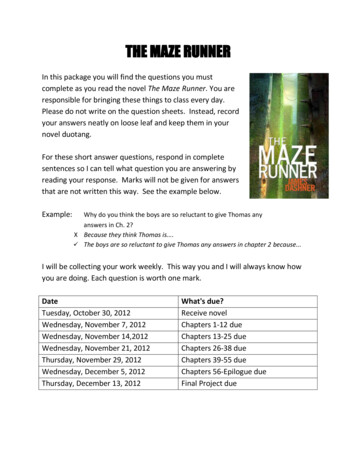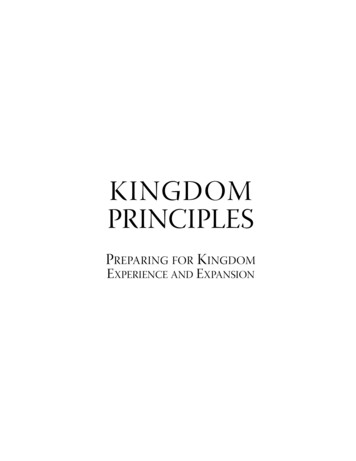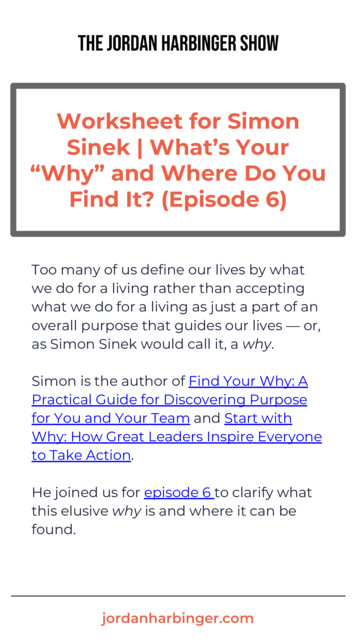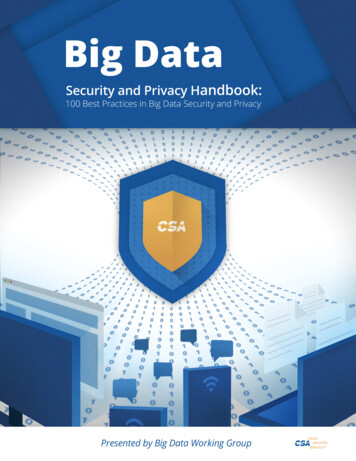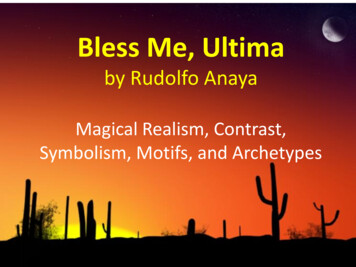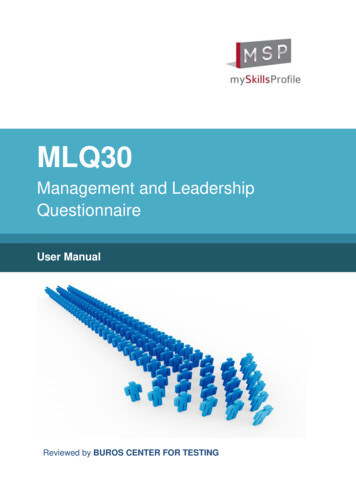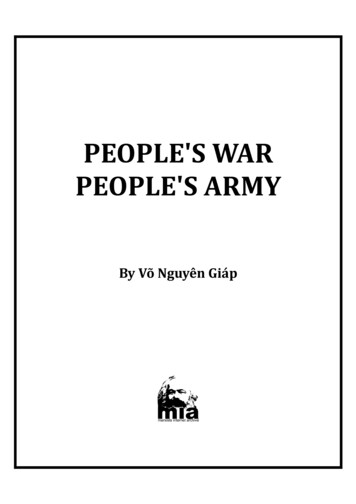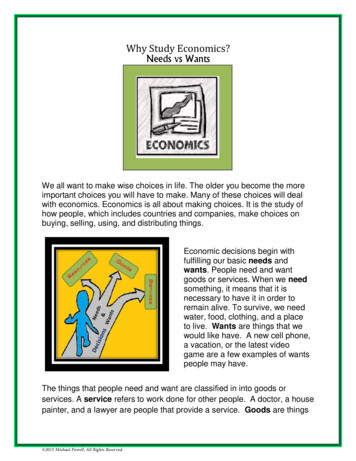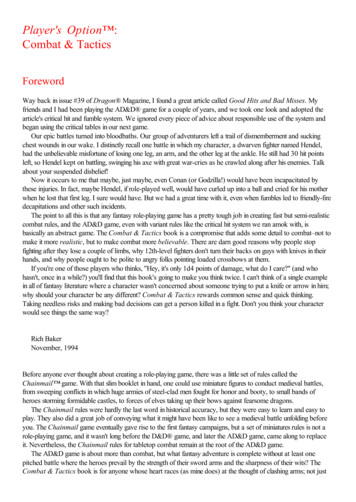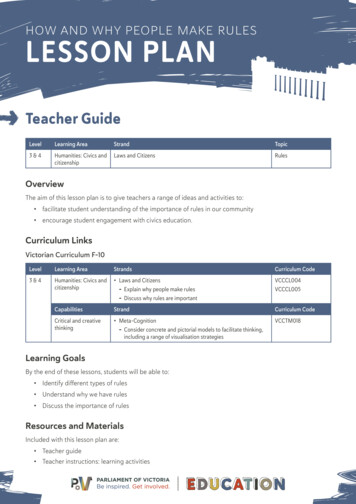
Transcription
HOW AND WHY PEOPLE MAKE RULESLESSON PLANTeacher GuideLevelLearning AreaStrandTopic3&4Humanities: Civics andcitizenshipLaws and CitizensRulesOverviewThe aim of this lesson plan is to give teachers a range of ideas and activities to: facilitate student understanding of the importance of rules in our community encourage student engagement with civics education.Curriculum LinksVictorian Curriculum F-10LevelLearning AreaStrandsCurriculum Code3&4Humanities: Civics andcitizenship Laws and Citizens–– Explain why people make rules–– Discuss why rules are lum CodeCritical and creativethinking Meta-Cognition–– Consider concrete and pictorial models to facilitate thinking,including a range of visualisation strategiesVCCTM018Learning GoalsBy the end of these lessons, students will be able to: Identify different types of rules Understand why we have rules Discuss the importance of rulesResources and MaterialsIncluded with this lesson plan are: Teacher guide Teacher instructions: learning activities
Challenges of being a leader worksheet Reflection worksheet Compare worksheetLearning Activities SummaryThese activities meet the needs of students working towards attainment of the Victorian Curriculum F-10 inLevels 3-4 in Civics and Citizenship.This lesson plan contains the following learning activities and resources:1.Warm-up brainstorm: Why do we have rules?2. Think / Pair / Share3. Class discussion: How and why do we have rules?4. Storytime5. Storytime: Share6. Storytime: Discuss7. Storytime: Reflection8. Exit pass: Why do people make rules9. Extension: Comparing how rules can be similar and differentAchievement StandardBy the end of these lessons students will meet the achievement standards in Levels 3 and 4 in Civics andCitizenship by being able to: Explain how and why people make rules Discuss why rules are important
HOW AND WHY PEOPLE MAKE RULESACTIVITIESLesson plan for teachersLearning intention Explain how and why people make rules Discuss why rules are importantSuccess Criteria1.I can talk about how and why people make rules2. I have some ideas about how or why people make rules3. I’m confused about why rules are a ting1. WARM-UP BRAINSTORM: WHY DO WE HAVE RULES?Start by having a list of class rules on the whiteboard(or use google image of traffic signs).Ask the class: ‘why do we have class rules?’ write downkey words or ideas on the board as a mindmap.Ask the class: ‘Why do we have school rules?’ in adifferent colour, write down any new key words orideas on the board.2. THINK / PAIR / SHAREFor the following question, use a Think / Pair / Sharetechnique (students think about their own ideas first,then they have 30 seconds to share their ideas withthe person sitting next to them, then the teacherchooses some pairs to report back to the class aboutwhat they discussed). Stress that there are no ‘correct’answers.What is one rule you love and one you hate at home?Why?- Tease out – fairness (eg sister not in my room), safety(eg don’t touch the stove).
3. CLASS DISCUSSION: HOW AND WHY DO WE HAVE RULES?Have a class discussion around the questions why dowe have rules; how do we make rules. The purposeof the discussion is to tease out that safety, fairness,equality and consequences are all part of having rules.Use the below prompts to explore the different partsof rulemaking: If someone new comes into our class, how do theyknow the rules? Why do they need to know the rules? What happens if our rules aren’t followed? Mind map as class – How did we make our rules?Are all rules made like that?– Possible responses: Vote, suggestion, oneperson decides4. STORY TIMEYou are King or Queen of an island.There are other people on the island, but you’re incharge. What rules would you make and why? (could putstimulus image up to assist) How would you make the rules? How would you make people follow the rules? What would happen if they didn’t? Is it different foreach rule? Sentence stems on board Possible to list or as a table rather than story Possible to draw the island – discuss signs, coloursthat mean yes or no, symbols Possible to dot point on butchers paper as a group5. STORY TIME – SHAREShare story with others – pairs, swap in a circle aroundtable, as a class etc.6. STORY TIME – DISCUSSWhat were any common rules – mind map (as table orclass)Did anyone have a rule you wish you had? What was itand why?Why are they common? Safety, fairness7. STORY TIME – REFLECTIONTask: Complete sentence stems in the attachedworksheet:Some people make rules because A good rule to help keep people safe is A good rule in the classroom to be fair is.A rule can be made by 8. EXIT PASS: WHY DO PEOPLE MAKE RULES?Students write a number with their reflection responseto show their understanding and measure theirpersonal success.1. I can talk about how and why people make rules2. I have some ideas about how or why people makerules3. I’m confused about why rules are a thing
9. EXTENSION: COMPARING HOW RULES CAN BE SIMILAR AND DIFFERENTOption oneOption twoComplete a venn diagram to show how rules at homeand rules at school can be similar and different.Complete the worksheet diagram to show similaritiesand differences between rules at home and at school.Once the diagram is complete, use think pair share todiscuss how their results may be different to someoneelse.
HOW AND WHY PEOPLE MAKE RULESACTIVITIESLesson plan for teachersLearning intention Explain how and why people make rules Discuss why rules are importantSuccess Criteria1.I can talk about how and why people make rules2. I have some ideas about how or why people make rules3. I’m confused about why rules are a ting1. WARM-UP BRAINSTORM: WHY DO WE HAVE RULES?Start by having a list of class rules on the whiteboard(or use google image of traffic signs).Ask the class: ‘why do we have class rules?’ write downkey words or ideas on the board as a mindmap.Ask the class: ‘Why do we have school rules?’ in adifferent colour, write down any new key words orideas on the board.2. THINK / PAIR / SHAREFor the following question, use a Think / Pair / Sharetechnique (students think about their own ideas first,then they have 30 seconds to share their ideas withthe person sitting next to them, then the teacherchooses some pairs to report back to the class aboutwhat they discussed). Stress that there are no ‘correct’answers.What is one rule you love and one you hate at home?Why?- Tease out – fairness (eg sister not in my room), safety(eg don’t touch the stove).
3. CLASS DISCUSSION: HOW AND WHY DO WE HAVE RULES?Have a class discussion around the questions why dowe have rules; how do we make rules. The purposeof the discussion is to tease out that safety, fairness,equality and consequences are all part of having rules.Use the below prompts to explore the different partsof rulemaking: If someone new comes into our class, how do theyknow the rules? Why do they need to know the rules? What happens if our rules aren’t followed? Mind map as class – How did we make our rules?Are all rules made like that?– Possible responses: Vote, suggestion, oneperson decides4. STORY TIMEYou are King or Queen of an island.There are other people on the island, but you’re incharge. What rules would you make and why? (could putstimulus image up to assist) How would you make the rules? How would you make people follow the rules? What would happen if they didn’t? Is it different foreach rule? Sentence stems on board Possible to list or as a table rather than story Possible to draw the island – discuss signs, coloursthat mean yes or no, symbols Possible to dot point on butchers paper as a group5. STORY TIME – SHAREShare story with others – pairs, swap in a circle aroundtable, as a class etc.6. STORY TIME – DISCUSSWhat were any common rules – mind map (as table orclass)Did anyone have a rule you wish you had? What was itand why?Why are they common? Safety, fairness7. STORY TIME – REFLECTIONTask: Complete sentence stems in the attachedworksheet:Some people make rules because A good rule to help keep people safe is A good rule in the classroom to be fair is.A rule can be made by 8. EXIT PASS: WHY DO PEOPLE MAKE RULES?Students write a number with their reflection responseto show their understanding and measure theirpersonal success.1. I can talk about how and why people make rules2. I have some ideas about how or why people makerules3. I’m confused about why rules are a thing
9. EXTENSION: COMPARING HOW RULES CAN BE SIMILAR AND DIFFERENTOption oneOption twoComplete a venn diagram to show how rules at homeand rules at school can be similar and different.Complete the worksheet diagram to show similaritiesand differences between rules at home and at school.Once the diagram is complete, use think pair share todiscuss how their results may be different to someoneelse.
HOW AND WHY PEOPLE MAKE RULESSTUDENT WORK SAMPLESTeacher GuideThe below are examples of student samples of work for their story. They include an island built on minecraftand then discussed verbally; a short story by a queen of an island and a sign with short responses of rules.Sample:If I was queen of this Island first I would make a rule that no one can go outside after dark without getting myOk. I would make this rule so they stay safe and monsters don’t hurt them.I would make the rules on my own. Other people can suggest rules, but I decide. This is because it’s faster if Ijust do it.If people didn’t follow my rules they might get hurt. But they would also pay me to say sorry.Another rule is they do not cut trees every day or there will be none left. If they break this rule, they have togive me all of their wood.Sign on island:No taking flowers from other peopleIf not followed I’ll attack you and take your thingsNo building on my islandThis is fairNo hurting my wallRules by King XXX
HOW AND WHY PEOPLE MAKE RULESWORKSHEETComparing different rulesTask: Think about the rules you have at home and at school. Some of thesemight be the same rules, or they might be for the same reason. But some rulesmight be very different too!Complete the diagram to show how the rules might be similar and different:HOMESCHOOLHow are they alike?How do they differ?Who makes the rule?About food?About clothes?
HOW AND WHY PEOPLE MAKE RULESWORKSHEETReflectionTask: Complete the sentence stems below:START OF SENTENCESome people makerules because A good rule to helpkeep people safe is A good rule in theclassroom to be fair is A rule can be made by COMPLETE THE SENTENCE HERE
1. I can talk about how and why people make rules 2. I have some ideas about how or why people make rules 3. I’m confused about why rules are a thing Terminology Rules Safety Fairness Protection Law Voting 1. WARM-UP BRAINSTORM: WHY DO WE HAVE RULES? Start by having a list of class rules

![[Page 1 – front cover] [Show cover CLEAN GET- AWAY 978-1 .](/img/13/9781984892973-6648.jpg)
